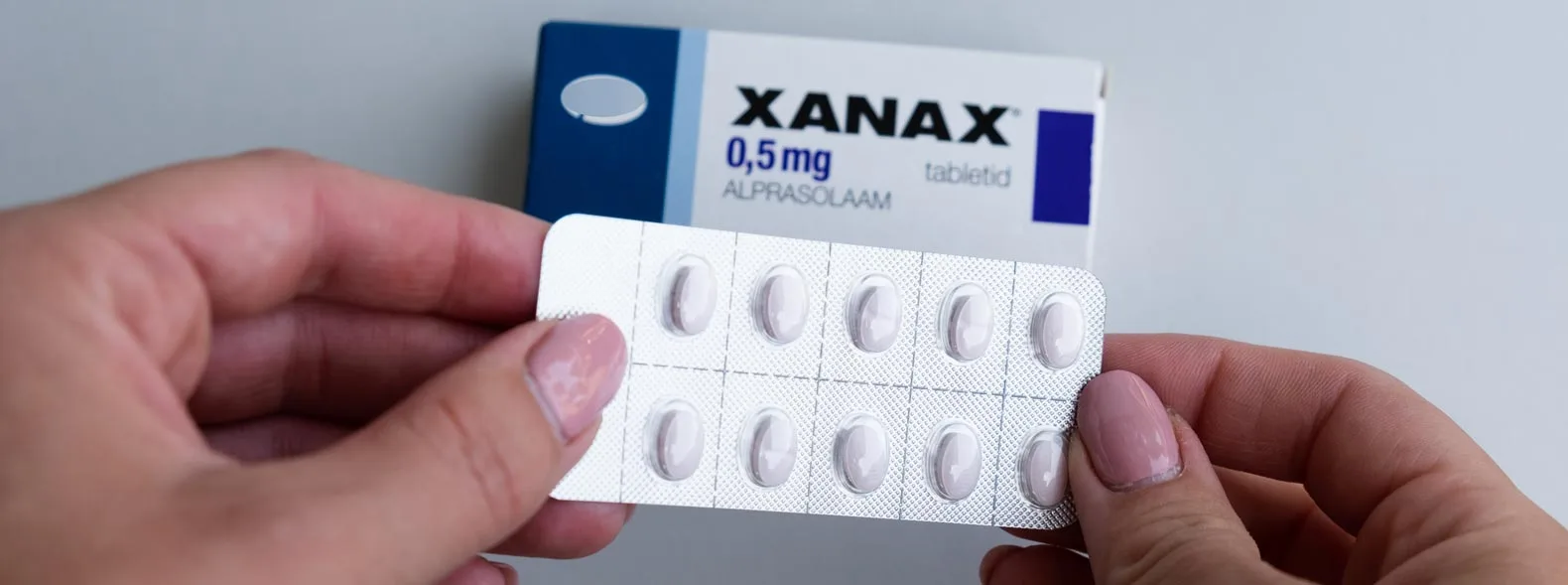
Xanax or alprazolam is one of the most commonly prescribed medications in the United States. It is a benzodiazepine that is used to treat anxiety, panic disorders, insomnia, and seizures. Since it is so common and relatively easy to access, people often assume it is completely safe to use. However, Xanax is highly addictive and people can experience dangerous withdrawal symptoms when they stop using it.
If you or a loved one is struggling with Xanax dependence or addiction, you need to seek professional help. In this article, we’ll share some of the common Xanax withdrawal symptoms and how they can be managed. We‘ll also explain why it’s so important to have medical assistance while you detox.
Why Can Xanax Be Dangerous?
Xanax is highly effective at controlling symptoms when taken as needed or on a short-term basis. However, when it is taken for a long time or taken in a way that’s not prescribed, it can become harmful.
Since Xanax has a calming effect on the brain, some people use it recreationally. They may abuse their prescriptions or get pills from illicit sources. People who abuse prescription Xanax use it more frequently than prescribed or take higher doses. While this may feel good in the short term, abusing Xanax can lead to dependence.
However, even people who use Xanax exactly as prescribed by their doctors can also become addicted. Even a few weeks of sustained usage can create physical dependence. When this happens, detoxification and rehabilitation become necessary. Xanax it is one of the most dangerous drugs to detox from since withdrawal symptoms can be highly uncomfortable and even life-threatening.
Detoxification is the process by which the body metabolizes substances and removes toxins from the system. It is an important step in recovering from addiction and it sets the stage for other interventions. Though it can be challenging, it is life-changing.
What Is Xanax Dependence?
Xanax and other benzos increase a chemical in the brain and nervous system that’s called gamma-aminobutyric acid-A or GABA. When you increase the amount of GABA in your body, your brain and nervous system become less sensitive to stimulation. This is why taking Xanax helps to control your mood and reduce anxiety. While all benzodiazepines work in the same way, Xanax is stronger than the others such as Klonopin, Ativan, Valium, and Librium.
Over time, the brain may stop producing GABA if there’s no Xanax in the body. This means the brain becomes dependent on Xanax to feel normal. When the drug leaves the bloodstream, the individual may experience uncomfortable Xanax withdrawal symptoms as the brain tries to achieve equilibrium. If you’ve become dependent on benzodizepines, you should never attempt to go through withdrawal without medical supervision.
Signs of Xanax Withdrawals
People who have been prescribed Xanax don’t always realize when they’ve become dependent. They may only realize it when their prescription runs out or they’re unable to take their usual dosage for some reason. Knowing the signs of Xanax withdrawals is important whether you have a prescription or not.
During withdrawal, people can experience both physical and psychological symptoms. Physical symptoms include:
- Tremors
- Sweating
- Heart palpitations
- Headaches
- Blurred vision
- Muscle pain
- Insomnia
- Loss of appetite
- Diarrhea
- Numb fingers
- Sensitivity to light and sound
Meanwhile, psychological Xanax withdrawal symptoms include:
- Anxiety
- Paranoia
- Hallucinations
- Panic
- Irritability
- Short-term memory loss
- Mood swings
- Difficulty concentrating
- Nightmares
Factors Affecting Xanax Withdrawal
Not everyone will experience withdrawal in the same way. About 40 percent of people who take Xanax for more than six months may experience severe symptoms. The others are more likely to notice mild symptoms. Some of the factors that contribute to the severity of withdrawal include:
- Genetics
- Age
- The method of ingestion
- The dosage
- The length of time the person has been using Xanax
- Whether the person is also using other drugs or alcohol
These factors help to determine the severity and duration of your symptoms.
Xanax Withdrawals Timeline: How Long Can Withdrawal Last?
Each person will have a different experience when they go through withdrawal. The experience is likely to be most unpleasant for people who took large doses and/or took Xanax for an extended period. Also, people who use Xanax in a way that it’s not intended can experience more severe symptoms.
Xanax is usually intended for oral use. However, people who use it recreationally sometimes crush the pills and snort them. This releases the drug into the bloodstream much more quickly and increases the risk of overdose, especially when Xanax is combined with alcohol or other drugs. Simply mixing Xanax with other substances can make the withdrawal process take longer.
Xanax withdrawal can follow a rough timeline although each person will have a different experience. Here’s what you may experience during the first four weeks.
Days One to Three
The first 72 hours of Xanax withdrawal tend to be the most painful and medical supervision is a must during this time. This is when the risk of seizures is at its highest. Other early symptoms include:
- Vomiting
- Rapid heartbeat
- Insomnia
- Mood swings
- Violent tendencies
Remainder of Week One
The worst is usually over by this point but Xanax withdrawal symptoms can continue to be challenging. People who were taking Xanax for anxiety may experience rebound symptoms. This period may also be characterized by nervousness, problems sleeping, and cravings for Xanax.
Week Two
By this point, physical withdrawal symptoms have typically subsided. However, intense emotional symptoms may linger. The individual may experience irritability, mood swings, depression, and insomnia. However, the risk of seizures has mostly passed.
Weeks Three to Four
Sleep may become easier during these two weeks. However, individuals may still feel a desire to use Xanax and they may experience some emotional and mental symptoms. By the end of the fourth week, most of the symptoms are gone but it may take a few months for them to go away completely.
Risks of Home Xanax Detox
Some people think they can manage Xanax withdrawal symptoms on their own. It is true that some individuals only experience mild effects. However, as you can now see, detoxing from Xanax at home can be dangerous and the process will be more uncomfortable than it needs to be. Some groups of people are even more at-risk for negative outcomes if they don’t have medical supervision.
For example, people who have been diagnosed with panic disorder, post-traumatic stress disorder, borderline personality disorder, bipolar disorder, or another serious mental illness need special care. Some of their symptoms which were controlled by Xanax may return when they go into withdrawal. It’s difficult to predict which symptoms will return so it’s best to be surrounded by experts 24/7.
Individuals who have a history of complicated substance withdrawal syndromes or underlying medical problems should also work closely with doctors to keep complications to a minimum. Elderly people and those in cognitive decline also need to be more careful.
Meanwhile, pregnant women or women who plan to become pregnant who are on prescription Xanax need to talk to their prescribing doctor and OB/GYN. They need to weigh the risks and benefits of tapering off the drug or continuing to use it. While some women are advised to continue taking benzos during their pregnancy, others follow a tapering schedule.
Even if you’ve been using Xanax without a prescription, you should still work with addiction and medical professionals to taper off your dosage. Healthcare workers are there to help you, not judge you. If you’re not comfortable reaching out to an addiction treatment center directly, you can talk to your primary care physician.
Can You Die from Benzo Withdrawals?
You may be wondering if dying from detox is possible. Xanax withdrawal can be deadly because of the risk of seizures. These are more likely to occur if you were taking high doses and you stop taking Xanax abruptly. However, seizures are possible even with smaller doses. Also, the worst withdrawal symptoms may result in suicidal thoughts or actions. That’s why discontinuing Xanax on your own is not advisable.
Why Medical Assistance is Best When Coming Off Xanax
There are several ways in which doctors can make detox easier. Withdrawal symptoms can usually be reduced and controlled with a slow tapering schedule. By gradually reducing the amount of Xanax you take, you’ll be more likely to avoid the most severe withdrawal symptoms. Some patients even report that they don’t experience any symptoms when they are gradually weaned off the drug.
In some cases, a longer-acting benzodiazepine such as Valium may be used instead of Xanax during detox. It’s easier to taper off longer-acting benzo. Since Xanax is metabolized quickly, tapering it off causes the amount of the drug in the bloodstream to go up and down.
Once a doctor gets you stabilized on another benzodiazepine, they can then slowly wean you off over time. Keeping a small amount of a benzodiazepine in the bloodstream can control cravings and other withdrawal symptoms until the drug is completely out of your system.
Other Medications
Beta-blockers, antidepressants, sleep aids, and other medications may also be used to help control other symptoms. Some substance abuse treatment programs also offer holistic interventions such as acupuncture, meditation, and yoga to promote healing and relieve stress.
While you can detox from Xanax on your own, it’s much safer to seek professional treatment for Xanax withdrawals. If your symptoms are severe, you may need inpatient care. Not only will you have access to medical help 24/7 but you’ll get proper nutrition and hydration.
Medically-supervised detox doesn’t always prevent withdrawal symptoms completely but it makes them a lot more tolerable. A gradual tapering off of Xanax use gives the brain time to adjust to the absence of the drug. Entering a drug treatment program also helps to prevent you from giving into cravings and makes it more likely that you’ll move on to the next stage of recovery.
Once your condition has stabilized, you’ll be able to focus on therapy and counseling that will teach you how to live a drug-free life and get back on track.
Achieving Lasting Recovery from Xanax Dependence
Whether you’re obtaining Xanax illicitly or you have a prescription, you need to seek help if you’ve become dependent on it. Detoxing is an important first step towards recovery. However, it can be difficult and dangerous if you try to do it alone. That’s why it’s so important to seek professional assistance regardless of the circumstances that led to this point.
At Circle of Hope, we are staffed by highly trained professionals who will assess you and determine which approach is best for your unique needs. Then, we will ensure that you are as safe and comfortable as possible during detox. The more tolerable the detox process, the more likely it is that you’ll be able to fight your Xanax dependence or addiction.
Detoxing is only the start. You’ll also need therapy and counseling to help you to stay clean. Fortunately, we provide a continuum of care that ranges from residential treatment to standard outpatient services. We’ll work with you to come up with a treatment plan that’s suitable for both your current situation and your goals.
If you or a loved one is struggling with a substance abuse problem, call us today. We’ll answer your questions, provide advice, and do whatever we can to assist you. Calls to our facility are toll-free and confidential so there’s no need to try to navigate this process alone. Reach out to us today!

